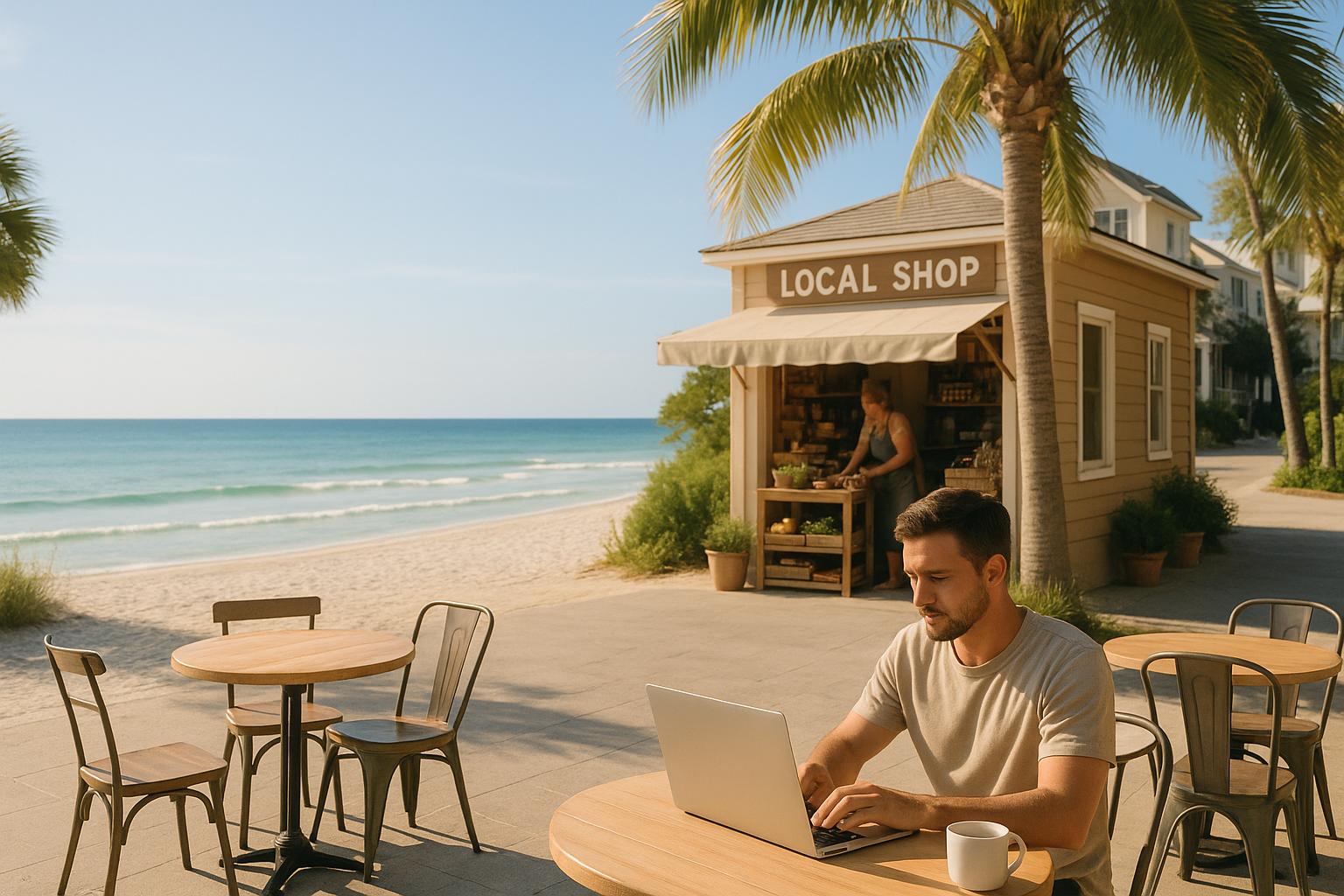Walton County, located in Florida's Panhandle, has undergone a major economic transformation over time. Here's a quick overview of its journey:
- Agriculture Era: Early settlers relied on farming staples like corn, sweet potatoes, and cotton. Livestock and barter systems supported self-reliance.
- Industrial Growth: By the late 1800s, the timber and turpentine industries dominated, creating jobs and driving infrastructure development. Freeport became a trade hub, connecting local goods to broader markets.
- Tourism Boom: Starting in the mid-20th century, Walton County shifted focus to tourism. The construction of Highway 98 and the rise of planned communities like Seaside turned the region into a premier coastal destination.
Each phase brought economic opportunities and challenges, from seasonal farming incomes to industrial deforestation and the complexities of managing tourism growth. Today, Walton County balances its role as a tourist hotspot with efforts to protect its natural beauty and address issues like housing affordability and infrastructure demands.
This rich history highlights how Walton County has adapted to change while preserving its identity.
Early Economy: Farming and Self-Reliance
First Settlers and Farming Methods
When early European settlers arrived, they brought with them a mix of determination and traditional farming practices. Using simple hand tools and draft animals, they cleared forests to create fields ready for planting. The subtropical climate required some adjustments, but they quickly adapted, growing crops that thrived in the region. Corn became a dietary staple, while sweet potatoes and cotton served dual purposes - feeding families and providing trade goods. Livestock like cattle, hogs, and chickens played a crucial role in supplementing food supplies and supporting the local barter system. These efforts built the foundation for an agriculture-focused economy.
Agriculture as Main Economic Driver
By the late 18th and early 19th centuries, farming wasn’t just a way to survive - it was the lifeblood of Walton County’s economy. Most families relied on their farms to meet daily needs and generate income, often producing enough surplus to trade locally. Barter markets became the heart of economic activity, where goods were exchanged and community ties strengthened.
Self-reliance shaped this early economic model. Families didn’t just grow food; they processed their crops and made essential items themselves. This way of life paved the way for the county’s gradual shift from a barter-based system to one involving cash transactions. The rhythm of daily life was deeply tied to the farming calendar, from preparing the land and planting to harvesting and processing. These seasonal cycles influenced not just the economy but also the social and communal activities of the time.
A History Of Walton County
Industrial Growth: Logging, Turpentine, and Freeport's Role in Trade and Distribution
By the late 1800s, Walton County began transitioning from its agricultural roots to embrace industrial opportunities, as its deforested lands revealed untapped resources.
Logging and Turpentine Operations
During this period, the timber industry became a cornerstone of Walton County's economy, reshaping local livelihoods. Sawmills proliferated across the region, processing the plentiful pine forests into lumber for construction and export. These mills drew workers from agricultural communities, offering new job opportunities and a shift in employment patterns.
Turpentine production also emerged as a vital industry. Workers, often referred to as turpentiners, harvested resin from pine trees, which was then processed into turpentine and other naval stores. Unlike farming, this provided a steady, year-round income, offering more financial stability to those involved.
Together, logging and turpentine operations connected Walton County's rural output to broader markets. To support the growing industries, improved roads and transportation routes were developed, enabling the movement of goods to ports and trading hubs. These advancements also paved the way for the rise of regional trade centers like Freeport.
Freeport's Role in Trade and Distribution
Freeport became a key commercial hub, fueled by the timber industry. Its location along strategic waterways, combined with connections to steamboats and schooners, made it an essential distribution point. This network allowed local producers to access distant markets, integrating Walton County's industrial output into the regional economy.
Although large-scale shipbuilding didn't take root in the area until much later, Freeport's role in trade and distribution was instrumental in shaping the county's economic development.
Agriculture vs. Industry Comparison
The shift from agriculture to industry marked a significant change in Walton County's economic foundation, bringing both opportunities and challenges.
| Aspect | Agriculture | Industry |
|---|---|---|
| Economic Impact | Seasonal income, local barter systems, family-based production | Year-round wages, cash-based economy, larger-scale operations |
| Population Growth | Slow, steady growth tied to available farmland | Rapid growth in industrial centers, worker migration |
| Risks | Weather-dependent, crop failures, local demand fluctuations | Market price volatility, resource depletion, transportation disruptions |
| Employment | Family labor, seasonal hiring, diverse skills needed | Specialized workers, steady employment, concentrated workforce |
| Infrastructure | Minimal roads, local markets, self-sufficient communities | Extensive transportation networks, processing facilities, supply chains |
The industrial sector brought a more reliable income through regular wages but introduced its own set of risks. While farmers dealt with unpredictable weather and crop failures, industrial workers faced market volatility and challenges tied to resource sustainability. For instance, the timber industry struggled with deforestation as harvesting exceeded the natural regrowth of forests.
This shift from agriculture to industry redefined Walton County’s economic identity, setting the stage for future developments in tourism and other modern industries.
sbb-itb-d06eda6
Tourism Era: Modern Economic Change
Walton County's economic story took a dramatic turn in the mid-20th century, as tourism began to replace the traditional industries that had long shaped the region. This shift brought about a significant transformation, offering new economic opportunities while introducing challenges for local communities navigating this change.
Tourism Development
Tourism didn’t emerge overnight in Walton County - it was a gradual process. Key infrastructure projects in the 1950s and 1960s, like the construction of Highway 98, made once-remote coastal areas more accessible. These improvements also connected inland communities to the growing tourism corridor along the coast.
The area's natural beauty became its most powerful draw. South Walton's beaches, with their powdery white sand and crystal-clear waters, stood out among Gulf Coast destinations. What started as a seasonal attraction evolved into a year-round destination, providing more stable employment compared to the unpredictable cycles of earlier industries.
Local entrepreneurs saw opportunity in this influx of visitors. Small, family-run motels and restaurants began popping up, laying the groundwork for what would eventually grow into a thriving hospitality sector. Over time, this early success paved the way for high-end resorts, fine dining establishments, and specialized services that cater to a more affluent clientele.
Planned Communities and New Urbanism
The 1980s marked a turning point with the rise of planned communities like Seaside, which introduced the concept of New Urbanism. These neighborhoods emphasized walkability and thoughtful design, creating spaces that felt both sustainable and inviting. Seaside’s success sparked a real estate boom, inspiring other upscale developments like Alys Beach in the 2000s.
Alys Beach, with its striking white architecture influenced by Bermudian design, became a hallmark of luxury living along the coast. These communities didn’t just attract visitors - they built entire lifestyle brands that appealed to both tourists and new residents. The economic ripple effects were significant, leading to higher-paying jobs in construction, hospitality, and professional services. Industries like architecture, interior design, and luxury retail flourished as skilled professionals and artisans moved to the area to meet growing demand.
Managing Tourism Growth
As tourism became Walton County’s economic backbone, officials worked to balance growth with the need to protect the area’s natural and cultural assets. The beaches, state parks, and coastal ecosystems that drew visitors in the first place required careful stewardship to ensure their long-term appeal and viability.
To address these challenges, the county adopted comprehensive planning measures. Regulations were put in place to limit building heights, require environmental impact studies, and protect public access to beaches. These efforts were aimed at preventing the kind of unchecked development that had harmed other coastal regions.
Tourism councils, funded by bed taxes and other fees, took on a central role in managing the industry. They invested in infrastructure, marketing campaigns, and events designed to attract a broader range of visitors and extend the tourist season. At the same time, traffic congestion along Highway 30A became a pressing issue, especially during peak times. Local authorities introduced shuttle services, promoted alternative transportation options, and improved roads to ease the strain while preserving the area's charm.
Environmental preservation also became a priority. Projects like beach nourishment and dune restoration helped maintain the natural features that made the region so appealing. Meanwhile, efforts to celebrate local culture - through festivals, historic site preservation, and support for heritage-based businesses - ensured that Walton County retained its unique character even as it grew.
Today, Walton County’s approach to tourism reflects a careful balancing act. By recognizing the interconnectedness of environmental preservation, community well-being, and economic success, the region has managed to turn tourism into a sustainable driver of prosperity. For more information, visit sowal.co.
Social and Economic Effects
Walton County's transformation from its agricultural and industrial origins to a tourism-driven economy has profoundly impacted residents' lives, the local population, and community traditions. These changes are particularly noticeable in the shifting demographics and social dynamics outlined below.
Population Changes and Community Mix
The county's population has evolved alongside its economic transitions. Early residents depended on farming, logging, and turpentine production, but the rise of tourism brought a wave of newcomers, including retirees, young professionals, and service industry workers. This influx has fueled population growth but also tested the fabric of the community. While many long-term homeowners have benefited from rising property values, these same increases have made it harder for some locals to afford homes. Traditional community events now share space with newer, tourism-driven cultural gatherings, reflecting the region's changing identity.
Income and Employment Trends
The shift to a tourism-based economy has redefined employment patterns. Seasonal service jobs dominate, leaving many workers to find additional income during slower months. On the other hand, roles in management, real estate, and construction have offered higher earning potential. Property ownership has emerged as a significant way to build wealth, though rising living costs have created challenges for seasonal workers. These evolving income patterns highlight a growing divide in financial stability, shaping both individual livelihoods and the broader community.
Economic Sectors Impact Comparison
Each economic phase has left its own legacy in Walton County. Agriculture promoted self-sufficiency and tight-knit communities. The industrial era brought stable wages and better infrastructure. Tourism, while offering lucrative opportunities and improved public services, also introduced challenges like seasonal income gaps and widening economic disparities. These shifts underscore the region's ability to adapt to changing circumstances.
For those interested in exploring how these economic changes continue to influence Walton County's culture and community life, resources like sowal.co provide valuable local perspectives.
Conclusion: Past Impact and Future Direction
Walton County's story is one of transformation - from its agricultural beginnings to industrial growth and, ultimately, to becoming a thriving tourism hub. Each phase has shaped its identity and laid the groundwork for its current status as a sought-after coastal destination.
How Economic History Shaped the County
The county's agricultural roots instilled a deep sense of self-reliance and community spirit. These values, born from early farming networks, still resonate in the way local organizations and businesses collaborate today.
The industrial era brought vital infrastructure and a broader skill set, smoothing the county's shift toward construction and development when tourism began to take hold. This period of growth prepared the community for its next chapter.
Tourism has since redefined Walton County, turning it into a destination economy while preserving its historical charm. Communities like Seaside and Rosemary Beach have embraced traditional architectural styles and walkable layouts, blending small-town heritage with the appeal of authentic visitor experiences.
This rich history now informs the county's approach to addressing modern challenges.
Future Challenges and Possibilities
As Walton County builds on its legacy, it faces the dual challenge of managing rapid growth while preserving its heritage. The county's strategic focus prioritizes protecting its natural beauty and cultural identity, ensuring that the pristine beaches and coastal ecosystems - key to attracting millions of visitors annually - remain intact.
Efforts are underway to diversify the economy and reduce reliance on seasonal tourism. By supporting year-round industries and businesses that cater to both locals and visitors, Walton County seeks to create more stable job opportunities and reduce income fluctuations.
Managing growth also brings pressing issues like housing affordability and infrastructure demands to the forefront. The tourism boom has been a financial boon, generating over $68 million in net tax benefits and saving each household more than $2,000 in 2024. However, careful planning is essential to ensure that development enhances rather than disrupts the community.
For those curious about the ongoing evolution of Walton County, platforms like sowal.co offer a window into how economic shifts continue to shape the culture and community life along the 30A corridor.
The county's journey - from agriculture to industry to tourism - provides valuable lessons for navigating the challenges ahead. By drawing on its past, Walton County is charting a path forward that balances growth with the qualities that make it a special place to live, work, and visit.
FAQs
How did Walton County's economy change as it moved from agriculture to other industries?
The move away from agriculture reshaped Walton County, sparking economic growth and creating a more stable foundation. Farming and timber once dominated the local economy, but the arrival of manufacturing and service industries introduced new job opportunities and eased the county's dependence on these traditional sectors.
This shift proved especially important during tough periods like World War II, when industrial expansion helped the area maintain economic stability. Now, Walton County enjoys a more diverse economy, with wider job prospects and a solid base for continued growth.
How does Walton County prioritize environmental preservation in its tourism efforts?
Walton County prioritizes protecting its natural beauty as a central part of its tourism efforts. By preserving the area's stunning landscapes, the county not only draws visitors but also improves life for those who call it home.
Local initiatives like beach cleanups, tree planting, and habitat conservation play a big role in these efforts. Programs such as Leave No Trace promote responsible travel habits, urging visitors to minimize their impact on the environment. These measures aim to maintain Walton County’s appeal and ensure its natural treasures remain intact for years to come.
What are the challenges Walton County faces in managing tourism growth while ensuring affordable housing and reliable infrastructure?
Walton County’s thriving tourism industry, pulling in billions each year, comes with its own set of hurdles - especially when it comes to affordable housing and infrastructure. As vacation rentals grow in popularity and property values soar, many locals are finding it harder than ever to secure affordable places to live.
On top of that, the surge in tourism is putting a lot of pressure on the county’s infrastructure. Roads, water systems, and public services are all feeling the strain. The challenge lies in finding a way to enjoy the economic perks of tourism while ensuring sustainable development that supports the community and keeps the county’s distinct character intact.



